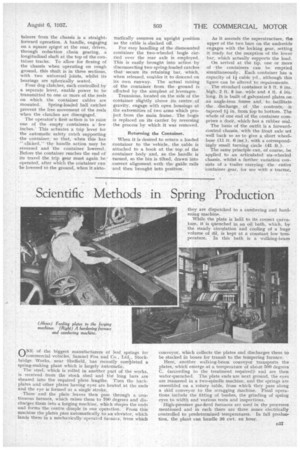Scientific Methods in Spring Production
Page 43

If you've noticed an error in this article please click here to report it so we can fix it.
nNE of the biggest manufacturers of leaf, springs for O vehicles, Samuel Fox and Co., Ltd,, Stockbridge Works, near Sheffield, has recently combleted a spring-making plant which is largely automatic.
The steel, which is rolled in another part of the works, is received from the stock shed and the long bars are sheared into the required plate lengths. Then the backplates and other plates having eyes are heated at the ends and the eye is formed at a single stroke.
These and the plain leaves then pass through a continuous furnace, which raises them to 700 degrees and discharges them into a forging machine, which shapes the ends and forms the centre dimple in one operation. From this machine the plates pass automatically to an elevator, which lands them in a mechanically operated furnace, from which they are dispatched to a camberingand hardening machine.
While the plate is held to its correct curvature, it is quenched M an oil bath, which, by the steady circulation and cooling of a huge volume of dil, is kept at a constant low temperature. In this bath is a walking-beam conveyor, which collects the plates and discharges them to be stacked in boxes for transit to the tempering furnace.
Here, another walking-beam conveyor transports the plates, which emerge at a temperature of about 500 degrees C. (according to the treatment reouired). and are then water quenched. The plate ends are next ground, the eyes are reamered in a two-spindle machine, and the springs are assembled on a rotary table, from which they pass along a skid conveyor to the scragging Machine. Final operations include the fitting of bushes, the grinding of spring eyes to width and various tests and inspections. High-pressure gas-fired furnaces are used in the processes mentioned and in each there are three zones 'electrically controlled to predetermined temperatures. In full production, the plant can handle 30 cwt. an hour.












































































